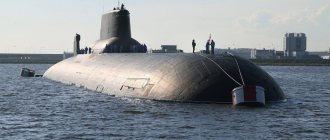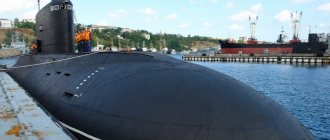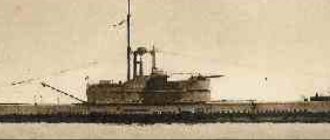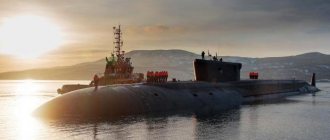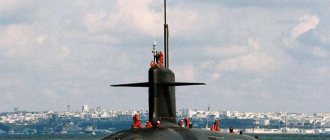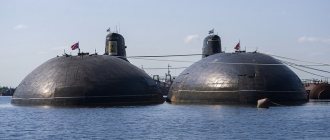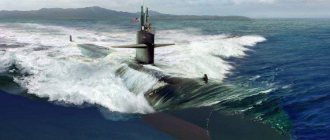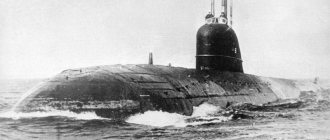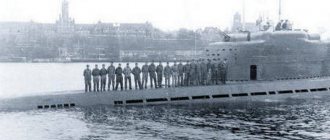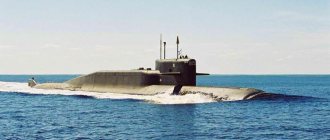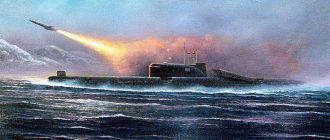With the advent of nuclear submarines (submarines), many began to express skepticism about submarines powered by electric-diesel engines. Despite this, such submarines are still in service in many countries around the world, including leading powers.
The persistence of diesel-electric submarines (DES) as a class is due to several disadvantages of nuclear-powered ships. The key ones are excessive noise, radiation background and large dimensions, which do not allow active operation in shallow water and in cramped conditions.
“Varshavyanka” is the combined name of two submarine projects powered by diesel generators (DPL). Initially, such submarines were produced for export; later they began to enter service with the Russian fleet.
A little history
In January 1954, a significant event occurred in the field of military development. The world's first nuclear submarine (NPS), Nautilus, was launched in the United States. This fact expanded the capabilities of submarines of that time, increasing not only autonomy, but also immersion depth, not to mention armament.
Related to this is the idea of the Soviet Union to create a submarine that would be superior to all enemy ships of this type. In the 60s of the last century, the country began to think seriously about protection against such threats.
Thus, the beginning of Project 636 and 877 Varshavyanka submarines was laid, modifications of which are in service with modern Russia.
The designers were faced with the task of equipping the submarine with a quiet engine, advanced target detection technology and powerful weapons. engineers worked diligently on these designs for seven years, starting in 1972 when the drawings were completed.
And already in 1982, the first Project 877 submarine was launched. It was planned to equip all countries participating in the Warsaw Pact with them, hence the second name.
Representatives of the series
| Name | Shipyard | Head No. | Bookmark | Launching | Commissioning | Fleet | Status as of 01/01/2020 | Note |
| Project 636 | ||||||||
| 366 Yuan Zhend 66 Hao | Admiralty Shipyards | 01616 | 16.07.1996 | 26.04.1997 | 26.08.1997 | PLA Navy | In service | |
| 367 Yuan Zhend 67 Hao | Admiralty Shipyards | 01327 | 28.08.1997 | 18.06.1998 | 25.10.1998 | PLA Navy | In service | |
| Project 636M | ||||||||
| 368 Yuan Zhend 68 Hao | Admiralty Shipyards | 01329 | 18.10.2002 | 27.05.2004 | 20.10.2004 | PLA Navy | In service | |
| 369 Yuan Zhend 69 Hao | Admiralty Shipyards | 01330 | 18.10.2002 | 19.08.2004 | 05.2005 | PLA Navy | In service | |
| 370 Yuan Zhend 70 Hao | Admiralty Shipyards | 01331 | 2004 | 04-05.2005 | 05.2005 | PLA Navy | In service | |
| 371 Yuan Zhend 71 Hao | Admiralty Shipyards | 01332 | 2004 | 26.05.2005 | 2005 | PLA Navy | In service | |
| 372 Yuan Zhend 72 Hao | Admiralty Shipyards | 01333 | 2004 | 26.08.2005 | 30.05.2006 | PLA Navy | In service | |
| 373 Yuan Zhend 73 Hao | Krasnoe Sormovo | 01611 | 07.1992 | 08.05.2004 | 05.08.2005 | PLA Navy | In service | |
| 374 Yuan Zhend 74 Hao | Sevmash | 01701 | 29.05.2003 | 21.05.2005 (04.06.2005) | 17.11.2005 (30.12.2005) | PLA Navy | In service | |
| 375 Yuan Zhend 75 Hao | Sevmash | 01702 | 29.05.2003 | 14.07.2005 (17.07.2005) | 24.11.2005 (30.12.2005) | PLA Navy | In service | |
| 021 Messali el Hadj | Admiralty Shipyards | 01336 | 2006 | 20.11.2008 | 28.08.2009 | Algerian Navy | In service | |
| 022 Akram Pacha | Admiralty Shipyards | 01337 | 2007 | 09.04.2009 | 29.10.2010 | Algerian Navy | In service | |
| Project 636.1 | ||||||||
| HQ-182 Hà Nội ("Hanoi") | Admiralty Shipyards | 01339 | 24.08.2010 | 28.08.2012 | 07.11.2013, 03.04.2014 | Vietnam Navy | In service | |
| HQ-183 Hồ Chí Minh ("Ho Chi Minh City") | Admiralty Shipyards | 01340 | 28.09.2011 | 28.12.2012 | 16.01.2014, 03.04.2014 | Vietnam Navy | In service | |
| HQ-184 Hải Phòng ("Haiphong") | Admiralty Shipyards | 01341 | 23.10.2012 | 28.08.2013 | 04.12.2014, 01.08.2015 | Vietnam Navy | In service | |
| HQ-185 Khánh Hòa (“Khanh Hoa”) | Admiralty Shipyards | 01342 | 23.10.2012 | 28.03.2014 | 13.05.2015, 01.08.2015 | Vietnam Navy | In service | |
| HQ-186 Đà Nẵng ("Danang") | Admiralty Shipyards | 01343 | 01.07.2013 | 28.12.2014 | 02.02.2016, 28.02.2017 | Vietnam Navy | In service | |
| HQ-187 Bà Rịa-Vũng Tàu ("Vung Tau") | Admiralty Shipyards | 01344 | 28.05.2014 | 28.09.2015 | 20.01.2017, 28.02.2017 | Vietnam Navy | In service | |
| 031 Ouarsenis | Admiralty Shipyards | 01346 | 2015 | 14.03.2017 | 02.10.2018, 09.01.2019 | Algerian Navy | In service | |
| 032 Hoggar | Admiralty Shipyards | 01347 | 2016 | 29.06.2017 | 26.11.2018, 09.01.2019 | Algerian Navy | In service | |
| Project 636.3 | ||||||||
| B-261 "Novorossiysk" | Admiralty Shipyards | 01670 | 20.08.2010 | 28.11.2013 | 17.09.2014 | Black Sea Fleet | Under repair | 09/21/2015 arrived in Novorossiysk |
| B-237 "Rostov-on-Don" | Admiralty Shipyards | 01671 | 21.11.2011 | 26.06.2014 | 30.12.2014 | Black Sea Fleet | Under repair | 12/16/2015 arrived in Novorossiysk |
| B-262 "Stary Oskol" | Admiralty Shipyards | 01672 | 17.08.2012 | 28.08.2014 | 03.07.2015 | Black Sea Fleet | In service | 07/01/2016 arrived in Novorossiysk |
| B-265 "Krasnodar" | Admiralty Shipyards | 01673 | 20.02.2014 | 25.04.2015 | 05.11.2015 | Black Sea Fleet | In service | 08/09/2017 arrived in Sevastopol |
| B-268 "Veliky Novgorod" | Admiralty Shipyards | 01674 | 30.10.2014 | 18.03.2016 | 26.10.2016 | Black Sea Fleet | In service | 03/29/2019 arrived in Sevastopol |
| B-271 "Kolpino" | Admiralty Shipyards | 01675 | 30.10.2014 | 31.05.2016 | 24.11.2016 | Black Sea Fleet | In service | 05/03/2019 arrived in Novorossiysk |
| B-274 "Petropavlovsk-Kamchatsky" | Admiralty Shipyards | 01614 | 28.07.2017 | 28.03.2019 | 25.11.2019 | Pacific Fleet | In service | In 2022, it will become part of the 19th brigade of the Primorsky flotilla of heterogeneous forces of the Pacific Fleet |
| B-603 "Volkhov" | Admiralty Shipyards | 01615 | 28.07.2017 | 26.12.2019 | 25.11.2020 | Pacific Fleet | Launched | |
| B-602 "Magadan" | Admiralty Shipyards | 01616 | 01.11.2019 | 12.2020 | 25.11.2021 | Pacific Fleet | Under construction | Hydraulic tests of the durable hull have been completed, insulation and installation work has begun |
| B-588 "Ufa" | Admiralty Shipyards | 01617 | 01.11.2019 | 03.2021 | 25.11.2021 | Pacific Fleet | Under construction | Hydraulic tests of the durable hull have been completed, insulation and installation work has begun |
| B-? "Mozhaisk" | Admiralty Shipyards | 01618 | 11.2020 | 12.2021 | 25.11.2022 | Pacific Fleet | Contract signed | |
| B-? “” | Admiralty Shipyards | 01619 | 11.2020 | 03.2022 | 25.11.2022 | Pacific Fleet | Contract signed |
Appearance and structure of the submarine "Varshavyanka"
The ideally streamlined shape of this diesel-electric submarine “Varshavyanka” was designed based on the results of numerous tests. Experiments with the shape lasted until the appearance of a submarine of the same type in the United States, called Alkabor, whose cetacean hull was repeated in the Soviet submarine.
This shape allows you to reduce hydraulic resistance and swim faster. In addition, this type of housing further reduces noise, because friction is minimal. In addition to all this, this submarine minimally reflects echolocation signals due to a special coating.
As you know, the design of the boat is two-part, based on a light and durable hull. The space between them is filled with main ballast tanks. On the hull itself there is a massive lightweight cabin to protect retractable devices and antennas. It is located directly above the second compartment of the boat.
The Varshavyanka-class submarine has folding horizontal control rudders at the front.
On the bow of the boat, which is divided into two decks, there are torpedo tube shafts on top and a sonar antenna on the bottom, which is used to detect targets. Moving towards the stern, you can count six compartments.
After the bow there are the first three compartments on three decks.
The first contains torpedo tubes on the upper deck, the middle one houses part of the crew, because one of the living decks is there. At the very bottom are the batteries.
The second compartment can be regarded as a command post; on its three levels there is a central post, a navigation room and a radio room, respectively.
The third compartment, with two living decks and a battery room, is the last three-deck compartment.
The diesel submarine of the Varshavyanka project is equipped with two types of engines located in the last three compartments. So, in the fourth compartment there is a diesel engine. An electrical unit is installed in the adjacent compartment, and at the very end there are power plants of the same type, but less powerful. Their main task is to ensure economical running.
Why was a diesel submarine needed?
After the fleets of potential opponents of these cruisers, invisible on the surface, appeared in service, similar ships began to be built for the USSR Navy. It soon became clear that the samples of domestic nuclear submarines differed from foreign ones, and not for the better. Acoustic means of detecting them quickly detected them by the noise of the propellers and engines. This problem was solved later, and in the late sixties and early seventies they decided to give an asymmetric response to external threats. In 1974, the Rubin Design Bureau received a technical specification from the Commander-in-Chief of the Navy S.G. Gorshkov, which listed the main requirements for the new ship: low visibility, a wide functional range and a reduced number of crew members. Four years later, the first Varshavyanka rolled off the stocks in Komsomolsk-on-Amur. The submarine complied with all points of the technical specifications, and in many respects even exceeded the parameters specified in it.
Technical characteristics of "Varshavyanka"
Let's start with dimensions and continue with maneuverability. With a width of about 10 meters, the length of the Varshavyanka submarine is 73.4 m. With such dimensions, the surface displacement is more than 2300 tons with a draft of approximately 6 meters.
When moving above water, the submarine can reach a maximum speed of 17 knots.
All of the above increases when the submarine is immersed in water. So about 1600 tons are added to the displacement, and another 3 knots to the speed. The maximum diving depth is 300 meters, but 240 m is considered optimal. Under water, “Varshavyanka” is a little faster.
Good maneuverability is ensured by a hybrid engine consisting of a pair of 1500 hp diesel generators. each and an electric motor with a power of 5500 hp. Additional electric motors are used to improve maneuverability. In addition to all this, there is a special 190 hp electric unit on board, designed for economical running.
All of the above is relevant for the model 877 project and its modifications. And for the 636 the same figures are true, but with minor improvements, for example, a slightly higher speed under water, by about 3 knots. Strictly speaking, these are the submarines that are considered the most effective and are used in the Russian Navy. In addition to the main series submarine, the Russian fleet has various modifications.
The operation of this equipment is impossible without a crew of 52 people. With this composition on board, the boat can operate autonomously for 45 days.
The maximum cruising range is 400 miles, but when equipped with RDP technology, a Varshavyanka-type boat can increase this figure to 6,000 miles.
The RDP allows you to replenish liquefied air supplies for the crew without rising to the surface. Also, this system is involved in the ventilation of the engine compartment of diesel generators, removing exhaust through retractable pipes. Air flows through the same pipes.
Low visibility
Sonar works on the same principle as conventional radar. Sonar emits short pulses of sound frequency, which, when reflected from underwater objects, create a picture of the situation. As in the Stealth system, means to reduce the visibility of submarines are mainly based on reducing the reflectivity of the surface. “Varshavyanka” is protected with such special material. The submarine is covered with a special sound-absorbing layer, which reduces the noise emanating from the ship's machinery and mechanisms, and at the same time absorbs hostile sonar signals.
Turbulence and cavitation, which inevitably occur near the rudders, prompted the Rubin designers to move them closer to the midship frame (the center of the hull).
But to ensure low visibility, it is not enough to be a “black hole” (as Project 877 was called by hydroacoustics of the NATO fleets). After all, “Varshavyanka” was not created for idle walks on the sea. The submarine itself must hunt enemy ships, and for this it needs “eyes” and “ears”. Finding the enemy before he can see you is the main task of the crew. There are two types of sonars: active and passive. The first ones emit acoustic pulses, they operate at a greater distance, but at the same time unmask the ship. The latter use the results of other sonars and sea noise; they are more difficult to use, but safer. The Varshavyanka class submarine has both types of sonars and, in addition to them, a sophisticated system for processing the received information based on an onboard computer. “Acoustic tunnel” technology is used, which reduces lateral sonar emissions.
Armament of the submarine "Varshavyanka"
As mentioned above, this diesel-electric submarine was designed to have an advantage in a duel. To do this, she was equipped with 6 torpedo tubes, launching 533 mm torpedo missiles.
There are 18 torpedoes in ammunition, with six already loaded in the TA.
You can also take on board 24 underwater mines.
The creators also took into account air defense systems. Therefore, it has a retractable Strela-3 MANPADS with eight missiles and four Kalibr anti-ship missiles.
All this makes Project 877 and 636 submarines especially dangerous in battle.
Representatives of the series
Project 877 diagram
Project 636 diagram
Varshavyanka-class submarines
, which combines projects 877 and 636 and their modifications, are the main class of non-nuclear submarines produced in Russia. They are in service with both Russian and a number of foreign fleets. The project, developed in the late 1970s, is considered very successful, so the construction of the series, with a number of improvements, continues in the 2010s.
| Name | Shipyard | Head No. | Bookmark | Launching | Commissioning | Fleet | State | Note |
| Project 636 | ||||||||
| 366 Yuan Zhend 66 Hao | Admiralty Shipyards | 01616 | 16.07.1996 | 26.04.1997 | 26.08.1997 | Chinese Navy | In service | |
| 367 Yuan Zhend 67 Hao | Admiralty Shipyards | 01327 | 28.08.1997 | 18.06.1998 | 25.10.1998 | Chinese Navy | In service | |
| Project 636M | ||||||||
| 368 Yuan Zhend 68 Hao | Admiralty Shipyards | 01329 | 18.10.2002 | 27.05.2004 | 20.10.2004 | Chinese Navy | In service | |
| 369 Yuan Zhend 69 Hao | Admiralty Shipyards | 01330 | 18.10.2002 | 19.08.2004 | 05.2005 | Chinese Navy | In service | |
| 370 Yuan Zhend 70 Hao | Admiralty Shipyards | 01331 | 2004 | 04-05.2005 | 05.2005 | Chinese Navy | In service | |
| 371 Yuan Zhend 71 Hao | Admiralty Shipyards | 01332 | 2004 | 26.05.2005 | 2005 | Chinese Navy | In service | |
| 372 Yuan Zhend 72 Hao | Admiralty Shipyards | 01333 | 2004 | 26.08.2005 | 30.05.2006 | Chinese Navy | In service | |
| 373 Yuan Zhend 73 Hao | Krasnoe Sormovo | 01611 | 07.1992 | 08.05.2004 | 05.08.2005 | Chinese Navy | In service | |
| 374 Yuan Zhend 74 Hao | Sevmash | 01701 | 29.05.2003 | 21.05.2005 (04.06.2005) | 17.11.2005 (30.12.2005) | Chinese Navy | In service | |
| 375 Yuan Zhend 75 Hao | Sevmash | 01702 | 29.05.2003 | 14.07.2005 (17.07.2005) | 24.11.2005 (30.12.2005) | Chinese Navy | In service | |
| 021 Messali el Hadj | Admiralty Shipyards | 01336 | 2006 | 20.11.2008 | 28.08.2009 | Algerian Navy | In service | |
| 022 Akram Pacha | Admiralty Shipyards | 01337 | 2007 | 09.04.2009 | 29.10.2010 | Algerian Navy | In service | |
| Project 636.1 | ||||||||
| HQ-182 Hà Nội ("Hanoi") | Admiralty Shipyards | 01339 | 24.08.2010 | 28.08.2012 | 07.11.201303.04.2014 | Vietnam Navy | In service | |
| HQ-183 Hồ Chí Minh ("Ho Chi Minh City") | Admiralty Shipyards | 01340 | 28.09.2011 | 28.12.2012 | 16.01.201403.04.2014 | Vietnam Navy | In service | |
| HQ-184 Hải Phòng ("Haiphong") | Admiralty Shipyards | 01341 | 23.10.2012 | 28.08.2013 | 04.12.201401.08.2015 | Vietnam Navy | In service | |
| HQ-185 Khánh Hòa (“Khanh Hoa”) | Admiralty Shipyards | 01342 | 23.10.2012 | 28.03.2014 | 13.05.201501.08.2015 | Vietnam Navy | In service | |
| HQ-186 Đà Nẵng ("Danang") | Admiralty Shipyards | 01343 | 01.07.2013 | 28.12.2014 | 02.02.201628.02.2017 | Vietnam Navy | In service | |
| HQ-187 Bà Rịa-Vũng Tàu ("Vung Tau") | Admiralty Shipyards | 01344 | 28.05.2014 | 28.09.2015 | 20.01.201728.02.2017 | Vietnam Navy | In service | |
| 031 Ouarsenis | Admiralty Shipyards | 01346 | 2015 | 14.03.2017 | 02.10.201809.01.2019 | Algerian Navy | In service | |
| 032 Hoggar | Admiralty Shipyards | 01347 | 2016 | 29.06.2017 | 26.11.201809.01.2019 | Algerian Navy | In service | |
| n/a | Admiralty Shipyards | 01348 | 2020 | Indian Navy | The possibility of construction is being considered | |||
| n/a | Admiralty Shipyards | 01349 | 2020 | Indian Navy | The possibility of construction is being considered | |||
| Project 636.3 | ||||||||
| B-261 "Novorossiysk" | Admiralty Shipyards | 01670 | 20.08.2010 | 28.11.2013 | 22.08.2014 | Black Sea Fleet | Under repair | As part of the 4th ObrPL Black Sea Fleet |
| B-237 "Rostov-on-Don" | Admiralty Shipyards | 01671 | 21.11.2011 | 26.06.2014 | 30.12.2014 | Black Sea Fleet | Under repair | As part of the 4th ObrPL Black Sea Fleet |
| B-262 "Stary Oskol" | Admiralty Shipyards | 01672 | 17.08.2012 | 28.08.2014 | 03.07.2015 | Black Sea Fleet | Under repair | As part of the 4th ObrPL Black Sea Fleet |
| B-265 "Krasnodar" | Admiralty Shipyards | 01673 | 20.02.2014 | 25.04.2015 | 05.11.2015 | Black Sea Fleet | In service | As part of the 4th ObrPL Black Sea Fleet |
| B-268 "Veliky Novgorod" | Admiralty Shipyards | 01674 | 30.10.2014 | 18.03.2016 | 26.10.2016 | Black Sea Fleet | In service | As part of the 4th ObrPL Black Sea Fleet |
| B-271 "Kolpino" | Admiralty Shipyards | 01675 | 30.10.2014 | 31.05.2016 | 24.11.2016 | Black Sea Fleet | In service | As part of the 4th ObrPL Black Sea Fleet |
| B-274 "Petropavlovsk-Kamchatsky" | Admiralty Shipyards | 01614 | 28.07.2017 | 28.03.2019 | 25.11.2019 | Pacific Fleet | In service | As part of the 19th BrPL PrFlRS Pacific Fleet |
| B-603 "Volkhov" | Admiralty Shipyards | 01615 | 28.07.2017 | 26.12.2019 | 25.11.2020 | Pacific Fleet | Mooring tests | Transfer to the fleet is planned for 2022 |
| B-602 "Magadan" | Admiralty Shipyards | 01616 | 01.11.2019 | 12.2020 | 25.11.2021 | Pacific Fleet | Under construction | Transfer to the fleet is planned for 2022 |
| B-588 "Ufa" | Admiralty Shipyards | 01617 | 01.11.2019 | 03.2021 | 25.11.2021 | Pacific Fleet | Under construction | Transfer to the fleet is planned for 2022 |
| B-? "Mozhaisk" | Admiralty Shipyards | 01618 | 11.2020 | 12.2021 | 25.11.2022 | Pacific Fleet | Getting ready to bookmark | Contract signed |
| B-? "Izhevsk" | Admiralty Shipyards | 01619 | 11.2020 | 03.2022 | 25.11.2022 | Pacific Fleet | Getting ready to bookmark | Contract signed |
Table colors:
Green -
operating as part of the Russian Navy
White -
not completed
Yellow -
operating as part of foreign navies or as a civilian ship
Advantages and disadvantages over nuclear submarines
Knowing the description of the characteristics of the Varshavyanka, you can compare it with the same nuclear submarines.
Diesel-electric engines are not a random choice, because... These units have a number of advantages that are superior to nuclear submarines. Namely:
- Quiet running;
- There is no such strong need for cooling;
- Easy to maintain.
Stealth is everything for a submarine, so it is very important to maintain it at the proper level. However, such a task is almost impossible given the noise from the operation of a nuclear reactor on a nuclear submarine, not to mention the high speed of propagation of sound waves in water. So diesel-electric submarines with their low-noise power plants look preferable.
Atomic reactions occurring in a nuclear submarine reactor are accompanied by strong emissions of heat.
If cooling is ineffective or insufficient, it can be damaged, which poses a threat not only to the crew, but also to the environment.
Therefore, for such submarines it is vitally important to maintain the recommended temperature regime of the power plant. For this, water is used, which creates a characteristic sound background. The same cannot be said about its competitors, because they only need good ventilation and radiators to work.
Maintenance of a nuclear reactor requires knowledge of nuclear physics and much more. This complicates, for example, the repair of non-critical damage. Diesel internal combustion engines are much lighter, so servicing them is not difficult.
The main disadvantage of diesel-electric submarines is the poor living conditions of the crew compared to nuclear-powered ships. This is not about the convenience of location or food for people on board, but about entertainment that distracts them from the psychological pressure of a long voyage.
This result was a consequence of reducing the size for less visibility.
Chassis
To recharge the batteries, this submarine does not need to surface; it is enough to raise the RDP (they are also called snorkels) to provide access to outside air and remove fuel combustion products. The diesel engine used is low-smoke, which reduces the visibility of the ship on the open sea.
Other innovations were also used. The main diesel engine (5.5 thousand hp) is not used to propel the vessel; its purpose is only to drive the rotor of the generator to charge the batteries. In the surface position, the propulsion is provided by an economical engine (power 130 hp), and two more (102 hp each) are reserve maneuvering. The kinematic scheme is such that all three engines drive one propeller. It is also special, with six blades, which allows it to rotate at a lower speed (250 rpm), producing, accordingly, less noise.
Buying countries of Project 636 and 877 submarines
The main share of produced boats of this type is used by Russia, which is logical. The Black Sea Fleet has 6 Varshavyankas in service, the latest modification 636.3, and the Russian Pacific Navy is preparing to receive the same number.
Among foreign buyers, China should be noted, which purchased a dozen submarines of projects 636 and 636M.
The Vietnamese fleet also uses 6 units of 6363.1.
Among African countries, Algeria is showing particular interest in submarines of this model, having two 636Ms and having signed an agreement to purchase a pair of 636.1s.
Use in combat conditions and duty support
Boats of the Varshavyanka project are in service with China, Vietnam and Algeria. In the last decade, 6 boats entered service with the Russian fleet, most of them patrol the Black Sea. The seventh boat is also completing state tests. It is expected that in 2017-22, six boats will join the Pacific Fleet.
The first combat use of the submarine was recorded on December 8, 2015. The B-237 "Rostov-on-Don" from the Mediterranean Sea successfully fired Caliber-PL missiles at the positions of Syrian terrorists in the province of Raqqa.
Interesting Facts
Interestingly, the seven-bladed propeller shaft on the tail rotates through wooden bushings. They were made from backaut wood, which released a resin with a consistency and action similar to a lubricant.
This solution allows you to use the same spare parts for about 20 years.
The NATO submarine "Varshavyanka" received the nickname "Black Hole" because of its tactical and technical characteristics, which allow it to silently sneak up on a target and hit it with certainty.
Steel that is not magnetic
A unique mooring base has been created in Novorossiysk to receive new submarines. According to Evgeniy Prokhorov, deputy head of the hydraulic engineering department of Spetsstroy of Russia, a trestle-type structure (gluing) on a pile foundation was used in the construction of the pier. In addition, special devices have been created for the safe mooring of a boat whose underwater control blades (“wings”) do not allow it to approach the quay wall directly.
In general, “Varshavyanka” began to be built quite a long time ago. In 1984, the first submarine of this class was sent on a ten-month ocean voyage. During the entire period of this raid, the Americans were never able to detect our ship, after which NATO firmly assigned the name “Black Hole” to boats of this class.
According to the director of the Admiralty Shipyards, Alexander Buzukov, Project 636 is a modernized, improved version of the first Varshavyanka. The ship's hull, reminiscent of a whale's outline, allows it to achieve impressive speed in a submerged position - almost 20 knots. At the same time, smooth, streamlined forms for “Varshavyanka” are created from solid pieces of metal. To connect the seams, special automatic welding is used, and each seam is tested for strength by X-ray and ultrasound.
The boat also provides relatively comfortable conditions for the crew to stay. There is air conditioning, a shower, and an improved waste disposal system. The wardroom can be quickly converted into, say, an operating room. The necessary medical equipment is also present on board. Moreover, everything, even the air conditioner, is equipped with noise-absorbing means. All this is in the interests of reducing the visibility of the ship.
The same goal is pursued by the use of special steel in construction. It has a low-magnetic property, that is, it significantly reduces magnetic fields. The magnet doesn't even stick to the boat's hull! In addition, the outer shell is complemented by a rubber coating, which also provides protection from detection by enemy radars. For example, the main shaft of the boat rotates not on metal bearings, but on... wooden bushings made from especially durable backout wood.
Defense24: Russian Varshavyanka submarines cannot stay under water for more than two days
The Polish portal Defense24 wrote about the shortcomings of the Russian Project 636 Varshavyanka submarines.
Submarines of the Varshavyanka project are among the quietest. But at the same time, they cannot stay under water for more than two days. And this is the main problem of this type of submarine, according to Polish analysts.
Considering that the submarines did not receive an air-independent propulsion system, they will have to float two days after diving. This makes it possible to track such submarines if there is an understanding of the area in which they may be located.
“Thus, the approximate operating area of Russian submarines is known, especially if it is clear which specific submarine we are talking about,” the article notes.
According to the authors of the publication, in the conditions of real military operations, Varshavyanka-class submarines will be vulnerable and will not be able to get close to enemy groups. Do they also claim that the “old” Russian Tu-22M3 and MiG-31K aircraft are not capable of withstanding the latest fifth-generation Western fighters, the F-35 Lightning II? as well as aircraft equipped with long-range radar detection systems.
Author of the text: Information agency “Informing”, registered by Roskomnadzor IA No. FS 77-79529
Source
